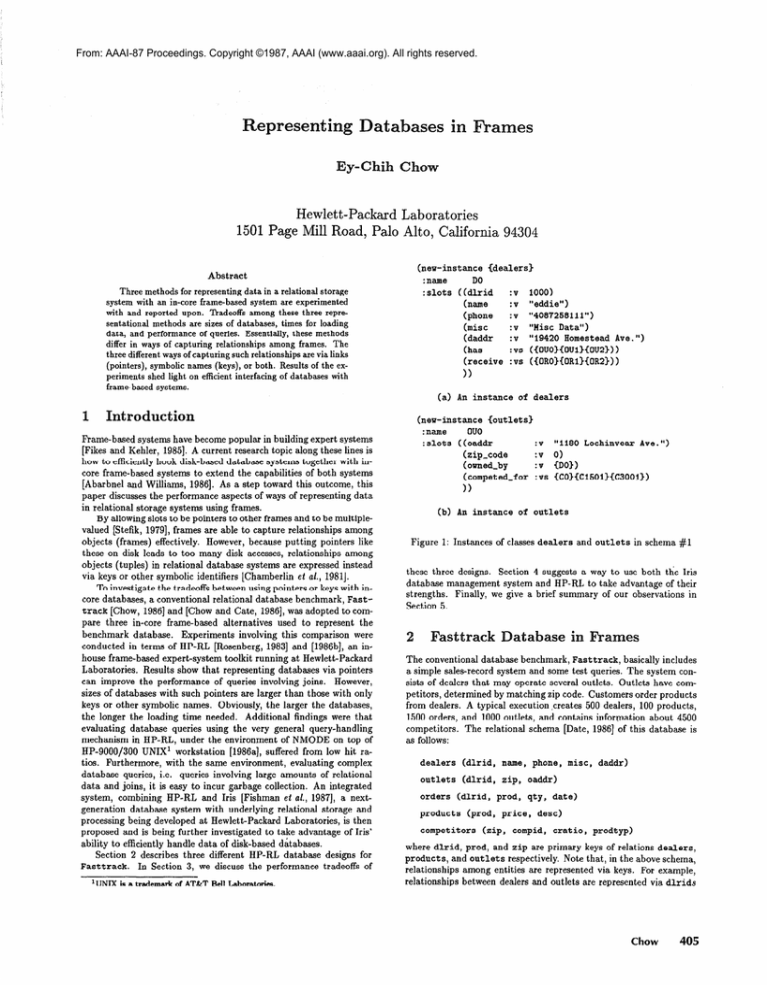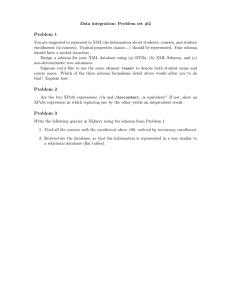
From: AAAI-87 Proceedings. Copyright ©1987, AAAI (www.aaai.org). All rights reserved.
Representing
Databases
Ey-Chih
in
ames
Chow
Hewlet t-Packard Laboratories
1501 Page Mill Road, Palo Alto, California
(new-instance
<dealers>
: name
DO
: slots
((dlrid
:v
(name
:v
(phone
:v
:v
(mist
:v
(daddr
(has
:vs
(receive
:vs
Abstract
Three methods for representing data in a relational storage
system with an in-core frame-based system are experimented
with and reported upon. Tradeoffs among these three representational methods are sizes of databases, times for loading
data, and performance of queries. Essentially, these methods
differ in ways of capturing relationships among frames. The
three different ways of capturing such relationships are via links
(pointers), symbolic names (keys), or both. Results of the experiments shed light on efficient interfacing of databases with
frame-based systems.
1
\\
‘UNIX is a trademark of AT&T Bell Laboratories.
1000)
“eddie”)
“408726811 I”)
“Mist Data”)
“19420 Homestead Ave. “1
(couo~~oul3~ou2>))
((OROH.ORiHOR23))
I/
(a> An instance
Introduction
Frame-based systems have become popular in building expert systems
[Fikes and Kehler, 19851. A current research topic along these lines is
how to efficiently hook disk-based database systems together with incore frame-based systems to extend the capabilities of both systems
[Abarbnel and Williams, 19861. As a step toward this outcome, this
paper discusses the performance aspects of ways of representing data
in relational storage systems using frames.
By allowing slots to be pointers to other frames and to be multiplevalued [Stefik, 19791, frames are able to capture relationships among
objects (frames) effectively. However, because putting pointers like
these on disk leads to too many disk accesses, relationships among
objects (tuples) in relational database systems are expressed instead
via keys or other symbolic identifiers [Chamberlin et al., 19811.
To investigate the tradeoffs between using pointers or keys with incore databases, a conventional relational database benchmark, Fasttrack [Chow, 19861 and [Chow and Cate, 19861, was adopted to compare three in-core frame-based alternatives used to represent the
benchmark database.
Experiments involving this comparison were
conducted in terms of HP-RL [Rosenberg, 19831 and [1986b], an inhouse frame-based expert-system toolkit running at Hewlett-Packard
Laboratories.
Results show that representing databases via pointers
can improve the performance of queries involving joins.
However,
sizes of databases with such pointers are larger than those with only
keys or other symbolic names. Obviously, the larger the databases,
the longer the loading time needed. Additional findings were that
evaluating database queries using the very general query-handling
mechanism in HP-RL, under the environment of NMODE on top of
HP-9000/300
UNIX1 workstation [1986a], suffered from low hit ratios. Furthermore, with the same environment, evaluating complex
database queries, i.e. queries involving large amounts of relational
data and joins, it is easy to incur garbage collection. An integrated
system, combining HP-RL and Iris [Fishman et al., 19871, a nextgeneration database system with underlying relational storage and
processing being developed at Hewlett-Packard Laboratories, is then
proposed and is being further investigated to take advantage of Iris’
ability to efficiently handle data of disk-based d&abases.
Section 2 describes three different HP-RL database designs for
Fasttrack.
In Section 3, we discuss the performance tradeoffs of
94304
of
(new-instance
Coutlets)
: name
ouo
:slots
((oaddr
(zip-code
(owned-by
(competed-for
1)
(b)
An instance
of
dealers
:v
:v
:v
:vs
“1180 Lochinvear
Ave. *I>
0)
(DO))
~CO)(Cl6Oi)(C3001))
outlets
Figure 1: Instances of classes dealers
and outlets
in schema #I
these three designs. Section 4 suggests a way to use both the Iris
database management system and HP-RL to take advantage of their
strengths. Finally, we give a brief summary of our observations in
Section 5.
2
Fasttrack
atabase
in
The conventional database benchmark, Fasttraclp, basically includes
a simple sales-record system and some test queries. The system consists of dealers that may operate several outlets. Outlets have competitors, determined by matching zip code. Customers order products
from dealers. A typical execution .creates 500 dealers, 100 products,
1500 orders, and 1000 outlets, and contains information about 4500
competitors.
The relational schema [Date, 19861 of this database is
as follows:
dealers
(dlrid,
name, phone,
outlets
(dlrid,
zip,
orders
(dlrid,
products
competitors
prod,
(prod,
(zip,
price,
misc.
daddr)
oaddr)
qty,
date)
desc)
corapid,
cratio,
prodtyp)
where dlrid,
prod, and zip are primary keys of relations dealers,
products,
and outlets
respectively. Note that, in the above schema,
relationships among entities are represented via keys. For example,
relationships between dealers and outlets are represented via dlrids
Chow
405
d
measurement
measurement
Figure 3: CPU and disk usages in processing an HP-RL query
former frame.
This section discusses performance tradeoffs among the above three
schemata. The discussions are divided into three parts: performance
of queries, database sizes, and loading.
3.1
Figure 2: Pointers vs. keys in the Fasttrack database
in relations outlets
and dealers
respectively, where dlrid
eign (primary) key of relation outlets
(dealers.)
is a for-
In terms of frames, the above database can be represented by three
alternative schemata. Each of these three schemata has the same five
classes of frames (or objects): dealers, orders, outlets, products, and
competitors. However, schema#l defines relationships among frames
with pointers only. With this schema, a pair of instances of classes
dealers
and outlets
respectively are shown in Figure la and lb. In
this figure, instances of frames OUn, n = 0,1,2, are frames of outlets,
ORn, n = 0,1,2, are frames of orders, DO is a frame of dealear, and
Cn, n = 0,1501,3001 are frames of competitors.
Curely brackets of
frames denote pointers to the frames. Finally, facet value (values)
of a slot is denoted by v (vs).
In this way, relationships between dealers and outlets, for example,
are represented via pointers of slots has and owned-by in instances
of classes dealers
and outlets
respectively.
Note that slot has is
multiple-valued.
Schema#2 defines relationships among frames with
only keys as the above relational representation. With this schema,
relationships between dealers and outlets are represented via keys of
slots dlrids in both classes outlets
and dealers,
where both dlrids
are single-valued. Schema#3 defines relationships among frames with
redundant information, using both key; and pointers. This schema
is used to investigate the possible performance improvement due to
such redundant information. Note that the notion of keys adopted in
schema #2 and schema #3 are borrowed from disk-based databases.
Scheme #l is a more typical representation for a knowledge representation language such as HP-RL. The three schemata are shown in
Appendix I.
Frames which use foreign keys to relate to other frames can be
deemed to have some implicit pointers among these frames. Namely,
foreign keys can be viewed as a kind of (slightly indirect) pointer.
With this viewpoint, schema #2, i.e. frames with keys only, can be
conceptually shown in Figure 2a, where pointers are implicit.
Frames which with pointers to other frames, on the other hand,
can be viewed as extended semantic networks [Rich, 19831 whose
nodes are frames themselves and whose arcs are pointers to other
frames. Schemata #l, i.e. frames with pointers to other frames, can,
therefore, be shown in Figure 2b, where pointers are explicit. The
meaning of pointers in Fig. 2b is that dealers have outlets and receive orders, orders are sent-to
dealers and order-for
products,
outlets are owned4y dealers and are competed-for
by competitors,
and competitors compete-for
outlets. Note that each pointer of a
frame pointing to another frame can be represented as a slot of the
406
Knowledge Representation
Performance
of Queries
I
We used six queries to test the above three schemata. In terms ofJSQL
[Date86], these six queries against the relational schema mentiOned
in section 2 are as follows:
ql92.
s3s4.
qs-
se.
select
phone from dealers
where dlrid
= 1260
select
dlrid
from outlets
where zip = 1260
select
oaddr,zip
from outlets
where dlrid
= 1370
select
cratio,compid
from outlets,competitors
where outlets.dlrid
= 1150 and outlets.zip
=
competitors.zip
select
dealers.name,products.desc
from
dealers,orders,products
where
orders.qty
between 10 and 20 and
dealers.dlrid
= orders .dlrid
and
products.prod
= orders.prod
select
prod,price,desc
from products
Queries qi, q2 and q3 include selections and projections. Queries
q4 and q5 are join queries. The selectivity factor of the join in q4 is
0.07%. The selectivity factors of the two joins in q5 are 0.2% and 1%
respectively. Query qe is a query to retrieve all the data in relation
prod.
As in Prolog
warren, 19811, forms of queries in HP-RL affect
their efficiency of retrieval tremendously. OpLimum ways to express
the above six test queries in HP-RL have been designed based on
our inspection of the underlying data statistics and structures of
schemata. We avoid joins as much as possible in expressing queries.
Optimum ordering of joins of queries are chosen according to the
underlying data statistics and the nature of the query-evaluation algorithm in HP-RL. We also take advantage of possible pointers between objects to express joins. The three groups of translated HP-RL
test queries for the corresponding three schemata are shown in Appendix II.
Measurements were based on running queries two consecutive
times and were made for each query right after garbage collection.
An interesting feature of response times for simple queries is that
after garbage collection, much useful code and data for query evaluation is not really in core and needs to be paged in. This incurs a
very low hit ratio. Therefore, the elapsed time for a query at the first
measurement is affected by the size of the underlying database and
is much longer than that at the second measurement. For example,
the elapsed time to process qi of schema #l at the first measurement
is a factor of 30 slower than at the second measurement.
Figure 3
shows snapshots of usage of system resources in processing an HP-RL
query. There is a big I/O peak the first time a query is processed and
almost no I/O the second time. The hit ratio is not as low if a query
1 HP-RL Schema#l
1st
¶l
L
1 HP-RL Schema#2
2nd
2.44
1
q6 1 15.36
1st
2nd
1 HP-RL Schema#J
1st
0.08
4.04
0.08
6.96
10.18
16.66
10.12
15.22
1 Iris
2nd
1
0.08
9
10.96
30
Table 3: Loading times of schema #l
Table 1: Response times of test queries (set)
HP-RL schema #l
HP-RL schema #2
HP-RL schema #3
1st
2nd
1st
2nd
1st
2nd
7.24
3.16
458.92
498.36
8.12
3.30
Table 2: Response times of the 1st answer of q6 (set)
is not posed right after garbage collection. Very often, response times
of ad hoc queries are 2 - 3 times that of the corresponding second
measurements mentioned above. The above phenomenon will be hidden when much garbage collection is involved in query evaluation,
that is, when there are many joins and duplicate answers of a query.
For example, processing q5 of schema #I the second time takes even
longer than the first time by a factor of 1.13. This is because the first
measurement is made right after garbage collection, which makes this
measurement have less garbage collection than the second one. The
HP-RI, command solve-all
suffers from garbage collection in processing joins involving large amounts of data because it is likely to
create many temporary frames in such processing. There is another
relatively specialized command in HP-RL, fast-solve-all,
which
partly solvea the above problem but does not relieve it entirely.
Table 1 shows response times for the six queries in HP-RL
schemata, listing both the first and second measurements.
Performance of the queries in Iris is also attached, where the numbers are
measured without index. Queries q3,q4, and q6 take longer in schema
#2 than in schema #l and #3. This shows that defining objects to
link through pointers is faster than naming keys of objects. Time savings of q5 in schema #l and #3 against schema #2 are only about
26%. This is because most of the time spent in processing this query
is used to eliminate duplicate answers. In q6, by replacing solve-all
with solve to measure times spent in getting the first answer, we find
that this query in schema #l or #3 is faster than in schema #2 by a
factor of 60. This measurement is shown in Table 2.
Note that, unlike schema #l, in schema #3 q2 avoids a join because each instance of outlets
has the key of its dealer. But q2
takes about the same time in schema #l and #3. Therefore, it is not
necessary to keep redundant information the way schema #3 does.
Now, we compare the performance of the HP-RL queries with that
of the corresponding Iris queries. For a reasonably high hit ratio, HPRL is superior to Iris in processing simple database queries such as q2
(HP-RL: at most 0.80s vs. Iris: with index 3.8s.) For an exceptional
low hit ratio, however, Iris performs better than HP-RL in processing
database queries (for q2, HP-RL: at least 5.74s vs. Iris: no index 4s.)
In addition, with pointers as in schema #1, HP-RL is able to
handle simple relational joins, i.e., joins not involving too many duplicates and data, better than Iris does (for 94, HP-RL: 0.86s vs. Iris:
with index 5s.) Iris, however, is much better than HP-RL at handling
complex relational joins, i.e., joins involving.many duplicates as well
as large amounts of data (for q6, HP-RL: = 600s vs. Iris: no index 57s.) Essentially, this is because HP-RL retrieval commands like
solve-all
and fast-solve-all
are intended to handle much more
general kinds of data than Iris does. Therefore, in the specific environment of databases, HP-RL suffers from garbage collection during
relational joins and eliminating duplicates.
3.2
atabase
Sizes
Sizes of the three HP-RL
databases
with the schemata
mentioned
(elapsed time)
in section 2 depend on how the slot is implemented.
For HP-RL
default slot declarations, slots have three facets: daemon, value, and
comment. In this case, sizes of the database are 2.73 Mbytes for
schema #l, 2.31 Mbytes for schema #2, and 3.15 Mbytes for schema
#3. However, for database-oriented frames like those of Fasttrack,
only one facet, i.e. value, for each slot is enough.
This can be
achieved with an HP-RL command to override the default declaration.
With this kind of slot implementation,
sizes of database are I.57
Mbytes for schema #l, 1.31 Mbytes for schema #2, and 1.70 Mbytes
for schema #3.
The database of schema #l is bigger than that of schema #2 because, although keys of objects are not used to represent relationships
among objects in schema #l, information associated with such keys
still needs to be kept. For example, key zip-code
of class outlets
of
schema #l cannot be ignored without losing information. Schema #3
uses redundant information of both pointers and keys in representing
relationships. Therefore, the associated database is the biggest of the
three HP-RL databases.
3.3
Loading
Due to frequent garbage collection, loading times of HP-RL databases
depend on sizes of free dynamic heap spaces where the Fasttrack
database is stored.
The size of the dynamic heap of the HP-RL
configuration used in these measurements is 5.82 mbytes with 4.56
mbytes free. In addition, to make the database smaller, each slot of
each frame to be loaded in this measurement allows only one facet,
i.e., value.
There is a problem in loading frames with pointers. As a frame
is loaded with reference to nonexistent frames, some partial frames,
i.e., frames with only headers but no bodies, are created and echoed
to the screen. Due to the expense of such ethos, sequences that load
objects with minimal numbers of ethos require minimal time. The
following two sequences of loading objects were tested:
sequence
#I.
sequence
t2.
products,
orders,
outlets.
products,
orders,
competitors.
dealers,
competitors,
outlets,
dealers,
Loading times of sequence #l and #2 for schema #l are shown in
Table 3. Loading via sequence #2 is slower than sequence #l because
of the following reason. During the loading of outlets with sequence
#2, instances of competitors
are nonexistent. Accordingly, partial
frames are created and are echoed to the screen. Since instances of
competitors
are much more numerous than those of the other four
classes. Ethos on loading via sequence #2 are more than those via
sequence # 1.
In the following discussions, loading times of databases of schema
#l and #3 were measured via loading sequence #l. Among the three
HP-RL databases, the loading times increase (about 104 : 131 : 157
mins for schema #2 : schema #l : schema #3) roughly in linear
proportion to the increases of the corresponding database sizes (1.31
: 1.57 : 1.70 mbytes), with a ratio about 1. In addition to the size
of the database, another reason that the database of schema #2 had
the shortest loading time is that no partial frames (and therefore no
ChOW
407
ethos) are created in loading this database.
To summarize, of the three HP-RL schemata, schema #3 does not
appear to have any advantage over schema #l. In contrast to schema
#2, schema #l trades good performance of queries for some memory
space and extra loading time. Finally, Iris is able to handle complex
joins better than HP-RL, although HP-RL is faster for simple queries.
4
Interffcing
Databases
.
with Frames
In this section, we propose a way to build high-performance knowledge
base systems by combining Iris and HP-RL.
Iris is designed to handle large amounts of data in wide ranges of
applications.
Expert systems built in HP-RL, however, deal with a
limited domain in a particular session. To achieve high performance
.using combined HP-RL and Iris, for a particular application domain,
we retrieve and transform related Iris data of relational forms into
frames and cache them in the HP-RL heap space during run time.
Note that retrieval of data in a particular domain from Iris databases
tends to involve complex joins. In addition, answers to queries from
Iris often include duplicates.
Such duplicates should be eliminated
before cache. In the transformation of Iris data to frames, relationships among these frames should be represented by either keys, as
in schema #2 mentioned in the previous sections or pointers, as in
schema #l. Considerations involved in selecting one of these two alternatives are memory sizes, loading time and performance of queries.
For example, if free space of HP-RL is sufficient and cached objects
are dynamically preloaded to HP-RL, then performance of queries is
the only consideration.
In this case, using pointers to link objects
(frames) is an appropriate way to gain efficiency.
Interfacing Iris with HP-RL in the above way tends to make Iris
handle complex joins and HP-RL handle simple queries. This achieves
high performance. The above discussion, however, does not address
the issues of update and insert as data are cached back to Iris. This
still needs to be investigated.
5
Conclusions
This paper uses some experimental results to describe the tradeoffs
among three representations of databases in frames. Representing relationships among frames via pointers will get better performance on
queries than will representation via keys or symbolic names. However, pointers will make the corresponding databases larger than will
keys or symbolic names. The same benchmarks are used to compare
the frame-baaed system, HP-RL, with the Iris database system, a
next-generation database system with underlying relational storage
and processing. Results show that for simple database queries, at a
reasonable hit ratio, HP-RL tends to be faster than Iris because data
for Iris queries are on disk. Because of its sophisticated buffer management strategy and relatively specialized code in handling data of
conventional databases, however, Iris is able to handle queries involving complex relational joins much better than HP-RL does.
Acknowlledgments
The author is grateful to Dan Fishman, Steve Rosenberg, Henry
Cate, Tom Ryan, Reed Letsinger, Bill Stanton, Pierre Huyn and Alan
Shepherd for most inspiring discussions and comments of this work.
Charles Hoch, Jim Davis, Wendell Fields, and Randy Splitter have
provided excellent and responsive support of the experimental environments. The author also thanks the referees for suggesting several
important improvements to the paper.
Appendix
I. Fasttrack
database
Schema #I
(define-class
dealers0
408
IKnowledge Representation
in HP-RE
:i.nstance-slots
:declare(single-valued) ;key of dealer;
((dlrid
:type number)
:declare(single-valued)
blll0
:type string)
(phone
:declare(single-valued)
:type string)
(mist
:declare(single-valued)
:typestring)
(daddr
:declare(single-valued)
:typestring)
:declare(multiple-valued)
;pointers
to outlets
(has
:typeContletd)
:declare(multiple-valued)
;pointers
to orders
(receive
:type{orders))
1)
(define-class
outlets0
:instance-slots
:declare(single-valued)
((oaddr
:typestring)
:declare(single-valued) ;keyof outlets
(zip-code
:typenumber)
:declare(single-valued) ;pointers
to dealers
(owned-by
:type{dealers))
(competed-for
:declare(multiple-valued)
;poiuters
to competito
rs
:typeIcompetitors3)
1)
(define-class
orders0
:instauce-slots
:declare(single-valued)
(WJ
:typenumber)
:declare(single-valued)
(date
:type string)
bent,t.o
:declare(single-valued) ;poiuters
to dealers
:type{dealers))
to products
(order-for :declare(single-valued) ;pointers
:type{products))
))
(define-class
products<)
:instance-slots
:declare(single-valued) ;k.eg of products
((prod*
:typenumber)
(price
:declare(single-valued)
:typenumber)
(desc
:declare(single-valued)
:typestring)
1)
(define-class
competitors0
:instance-slots
:declareMugle-valued)
((coupid
:typenumber)
(cratio
:declare(single-valued)
:typenumber)
:declare(single-valued)
(prodtype
:typestring)
(compete-for:declare(single-valued) ;poiuters
to outlets
:type{outlets))
))
Schema #2
(define-class
dealers0
:iustence-slots
((dlrid
:declare(single-valued) ;keyof dealers
:typenumber)
hme
:declareWugle-valued)
:typestring)
(phone
:declare(single-valued)
:typestring)
(mist7
:declare(single-valued)
:typestring)
(daddr
:declare(single-valued)
:typestring)
1)
(defile-class
outlets0
:instauce-slots
((dlrid
:declareMugle-valued) ;key of dealers
:typenumber)
(zip-code :declare(single-valued) ;key of outlets
:typenumber)
(oaddr
:declare(single-valued)
:typestring)
)I
(define-class
orders0
:instance-slots
((dlrid
:declare<single-valued) ;keyof dealers
(prod
WY
(date
:typenumber)
:declareKngle-valued) ;key of products
:typenumber)
:declare(single-valued)
:typenumber)
:declare(single-valued)
:typestring)
)I
(define-class
products0
:instance-slots
((prod?
:declare(single-valued) ;key of products
:typenumber)
(price
:declare(single-valued)
:typenumber)
(desc
:declare(single-valued)
:type string)
1)
(define-class
competitors0
:instance-slots
:declare(single-valued) ;keyof outlets
((zip
:typenumber)
(compid :declare(single-valued)
:typenumber)
Ccratio :declare(single-valued)
:typenumber)
(prodtype :declare(single-valued)
:typestring)
1)
Schema #3
Slotsof classesin this SChprma are combinations
of slotsof the
corresponding
classesin schema81 and t2. +++
Appendix
II. Test queries
in HP-RL
Schema #I
query 1
(solve-ally(CD260)phone ?x)
:returns'?x)
query 2
(solve-all'(and(?x zip-code1260) (?x osned,by?y) (?y dlrid ?z))
:types((?x{outlets))(?y {dealers)))
:returns'?a)
query3
(solve-all'(and(fD370)has ?x) (7x oaddr ?y) (?x zip-code?z))
:type '((?xfontlets)))
:returns'(?y?z))
query 4
(solve-all'(and(CD1501has ?x) (?x competed,for
?y)
(?y cratio?z) (?y compid?u))
:type'(C?x{outlets))(?y Icompetitors)))
:returns'(?z?a))
query 5
(solve-all'(and(snd (?y qty ?z) -(>= ?z 10) ^(<= ?z 20))
(?y order-for?P) (?P desc ?u) (?y sent-to?x)
(?x nsme ?v))
:type'((?yiorders))(?x {deders)))
:returns'(Pv?u))
query6
(solve-all'(and(?x prod6 ?y) (?I price ?z) (?x desc ?w))
:type J((?x<products)))
:returns'(?y?z ?u))
query 5
(solve-all'(and(?x qty ?z) (and -0= ?z 10) -(<= ?z 20))
(?x prod ?a) (?v prod6 ?a) (?x dlrid ?p)
(?u dlrid ?y) (0~ name ?ol) (?v desc ?vl))
:type'((?x{orders))(?v {products))
(?s fdealers)))
:returrm'(?ol?vl))
query 6
(solve-al1'(and(?I prods ?y) (?x price ?z) (?I desc 7111)
:type'((?x{products)))
:returns'(?J?z ?a))
Schema #3
et* Queries1,3,4,5and 6 in this schemaare of the same forms as
those in schema81. query 2 in this schema,on the other
hand, is of the same form as that in schema62. *e+
References
[19SSa] HP 9000 S eries 900 NMODE User’s Guide. Hewlett Packard
Company, 1986.
[1986b] HP-RL R ef erence Manual.
September 1986.
Hewlett
Packard
Laboratories,
[Chamberlin ed al., 19811 D. Chamberlin e2 al. A history and evaluationof system R. Communications of the ACM, 24( lo), October
1981.
[Fishman et al., 19871 D. Fishman et al. Iris: an object-oriented
dbms. ACM ‘Transactions on Ofice Information Systems, 5(2),
April 1987.
[Abarbnel and W i 11iams, 19861 R. Abarbnel and M. Williams. A relational representation for knowledge bases. In First Interna-
tional Conference on Expert Database Systems, 1986.
[Chow, 19861 E. Chow. Iris and HPRL. Technical Report STL-TM86-13, Hewlett Packard Laboratories, October 1986.
[Chow and Cate, 19861 E. Chow and H. Cate. Performance Evaluation for IRIS Version 1.0. Technical Report STL-TM-86-13,
Hewlett Packard Laboratories, October 1986.
[Date, 19861 C. Date. An Introduction to Database Systems.
ume 1, Addison-Wesley, fourth edition, 1986.
Vol-
[Fikes and Kehler, 19851 R. Fikes and T. Kehler. The role of framebased representation in reasoning. Communications of the ACM,
28(9), September 1985.
[Rich, 19831 E. Rich. Artifical Intelligence.
McGraw-Hill,
1983.
[Rosenberg, 19831 S. Rosenberg. HPRL: a language for building expert systems. In Proc. IJCAI, 1983.
[Stefik, 19791 M. Stefik. An examination of a frame-structured
resentation system. In Proc. IJCAI, 1979.
rep-
[Warren, 19811 D. Warren. Efficient processing of interactive relational database queries expressed in logic. In Proc. of 7th Int.
Conf. on VLDB, 1981.
Schema #t2
query 1
(solve-all*({D260)phone 7x)
:returns'?xL)
query 2
(solve-all'(and(?x zip-code1260) (?x dlrid ?y))
:typeJ((?x{outlets)))
:returns'?y)
query 3
(solve-all'(and(?x dlrid 1370) (?x oaddr ?y) (?x zip-code?z))
:type '((?xIoutlets)))
:returns'(?y?z))
query 4
(solve-all'(and(fDl60)dlrid ?P) (?x dlrid ?s) (?x zip-code?y)
(?z zip ?y) (?z cratio?a) (?z compid?v))
:type'((?x{outlets))(?z {competitors)))
:returns'(?a?v))
Chow
409






